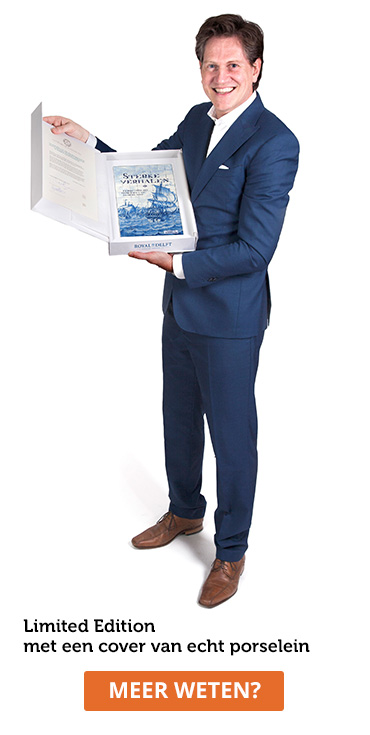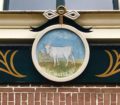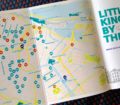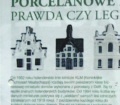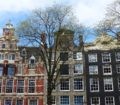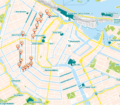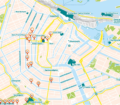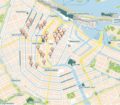With over 180 different nationalities, Amsterdam is the most cosmopolitan city in the world. It’s a colorful place full of contradictions. Tolerance is key in keeping Amsterdam in balance. On this tour, you’ll read the stories of the citizens who helped shape Amsterdam’s unique character. To many people, Amsterdam is synonymous with freedom, and credited with being the most tolerant city in the world. And even the city’s heraldic emblem and the phrase ‘Determined, Heroic and Compassionate’ refers to the DNA of Amsterdam. In a society dedicated to tolerance, cultural diversity stimulated the exchange of ideas, and turned out to be the driving force behind Holland’s prosperity. This tour invites you to explore Dutch tolerance through remarkable figures and locations related to this theme.
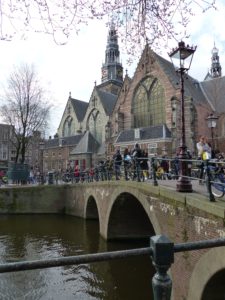

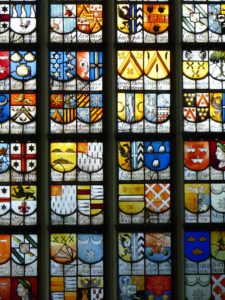

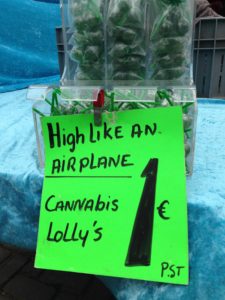

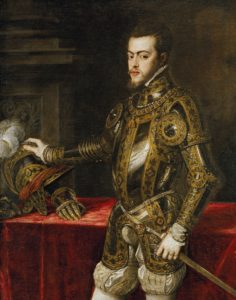
Oude Kerk (around 1213)
Oudekerksplein 23
We are now right in the middle of the infamous Red Light District. It is the only place on earth where religion and prostitution are smoothly mixed together. The Old Church, erected in the 13th century, is surrounded by cannabis-fumed coffee shops, brothels and window prostitution. Proud and stubborn, the 800-year-old church stands out. Even after all these years, the church is still a place of contemplation. A few steps away from its main doors, the inside and outside worlds are symbolized by a little bronze relief on the pavement, of a hand caressing a female breast.
Freedom of religion, freedom of speech, and freedom of expression were important motives behind the Dutch struggle for independence from Spanish oppression in 1568. During that era, the Dutch Reformation changed the religious atmosphere from Roman Catholic to Calvinism. After a non-violent revolution in 1578, the Catholic city council in Amsterdam was ousted by the Calvinists and the church became Protestant. From that moment on, Catholic citizens were allowed to follow their faith behind the facades of private residences and canal houses. These clandestine churches were generally tolerated.
If you wish to visit such a hidden church, just walk a few hundred meters towards the Zeedijk, to the north. At Oudezijds Voorburgwal 40, you’ll find ‘Our Lord in the Attic’. In 1663, this clandestine church was built in the canal house of a wealthy merchant. This house remained in use as a parish church for over 200 years and has been a museum since 1888.
But we are going the other way. Walk south.
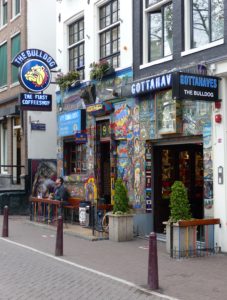
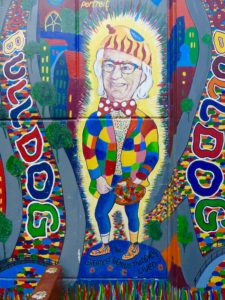

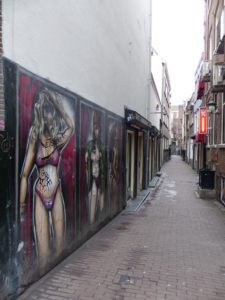
2. The Bulldog – the first coffee shop
Oudezijds Voorburgwal 88-90
Here we are, at number 90. Can you smell it? On December 17 1975, Henk de Vries ditched the toys of his father’s sex-shop into the canal and established the world’s first cannabis coffee shop, The Bulldog, named after Joris, the owner’s dog. Since the 1970s, the Dutch approach to soft drug use has been pragmatic and realistic. It is a common misconception that soft drugs have been legalized in Holland. The personal use of hashish or marijuana is tolerated, but their cultivation and possession remain a criminal offence. In a coffee shop, like the Bulldog, a regular coffee or cappuccino is just a secondary item on the menu. One funny side-effect of the ban on smoking cigarettes in bars is that joints are meant to be pure marijuana with no tobacco included.
Over 40 years, the Bulldog has earned its place in history. The first coffee shop has been expanded into an empire of five coffee shops and two hotels.
Turn right, around the corner from the Bulldog, into St. Annenstraat. Here you’ll find a number of red-lit windows. The prostitutes behind the doors try to attract the attention of male passers-by. Taking pictures of the women is not appreciated, so please don’t do it.
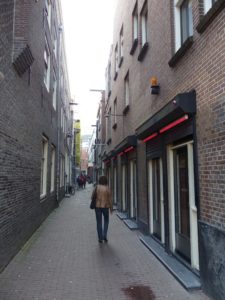
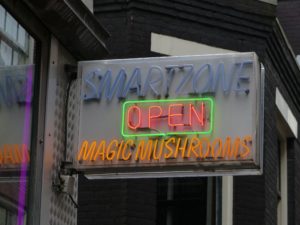
3. St. Annenstraat – window prostitution
During the Middle Ages, prostitution in Amsterdam was tolerated. The attitude of the city council and religious authorities towards prostitution was pragmatic. However, a number of conditions were imposed on prostitutes and their clients. For instance, prostitutes were not allowed to marry.
The Amsterdam Red Light District is much more relaxed and laid-back than red light districts elsewhere. Especially during the evenings, many people are present – men and women. This is a relatively safe part of Amsterdam. Usually, there are some drug sellers and pickpockets around, and you may hear a “Psst! Cocaine?” now and then. Just ignore the dealers and continue straight ahead.
Turn right at the end, into Warmoesstraat.

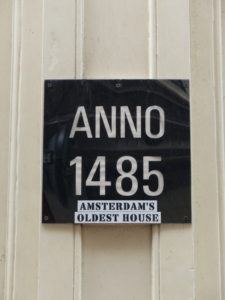
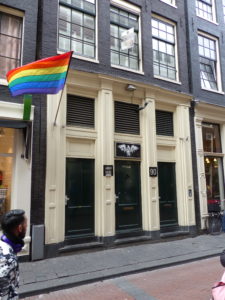
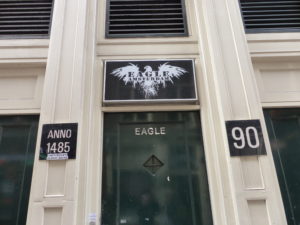
- Warmoesstraat 90
This is the Warmoesstraat. A few years ago, it was discovered that the oldest house in Amsterdam is located at number 90, further down the street. The five centuries-old building is hidden behind a rather boring non-descript façade. Scientific research proved that the original wooden skeleton of the construction dated from around 1485 and, to make the story even more special, the house is home to Amsterdam’s oldest gay venue – The Eagle, a men-only bar. For centuries, the Dutch have had a relaxed and tolerant attitude towards different lifestyles. Homosexuality was decriminalized in 1811, and the first gay bar opened its doors in 1927. However, we are not going to the Eagle bar, but stop at number 111.
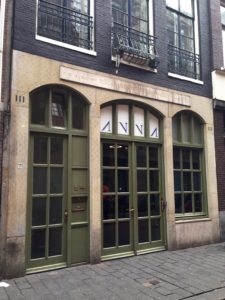
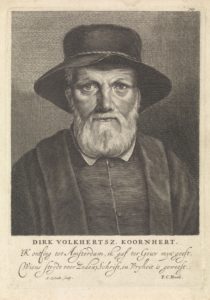
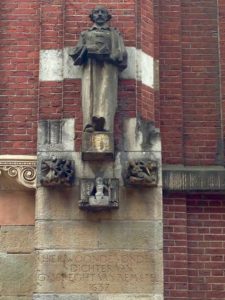
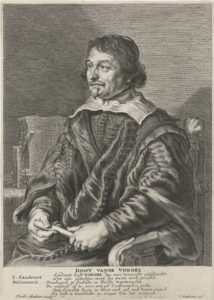
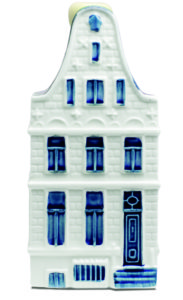
5. Dirck Volkertsz Coornhert and Joost van den Vondel
Warmoesstraat 111
You see Warmoesstraat 111, at the right? In 1552, Dirck Volckertsz Coornhert was born in this house. This famous Catholic philosopher took a stand against Calvinist extremism. He was a passionate supporter of religious freedom and the free expressions of every faith. He promoted peace through moderation and tolerance, but his liberal political views brought him into conflict with both Catholics and Protestants. This led to his imprisonment and ultimately Coornhert went into exile. Along with Erasmus, he is regarded as one of the founders of European humanism.
At the other side of street is a plague. That marks the former house of Vondel. He was the most prominent Dutch poet of the 17th century. Actually, he lived a few blocks further down. Like Dirck Volckertsz Coornhert, he was committed to promoting a tolerant society. In 1630, Vondel attended the opening of a clandestine church on Keizersgracht. This building is KLM house No. 40, which we will pass later on this tour. During the first service, the poet addressed the churchgoers and offered a heartfelt advice: ‘Do not over-glorify the splendor of visible churches’. The ability to worship was more important.
Vondel carefully picked his fights and raised his voice against injustice. By insulting politicians and foreign heads of state, he pushed the boundaries of his freedom of speech and was fined as a result. But Vondel could not care less. After all, he was the people’s poet and expressed the thoughts of the silent majority.
Let’s turn back and walk to Warmoesstraat number 141, were you’ll find a very special shop.

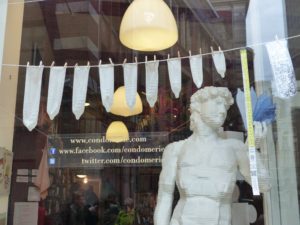
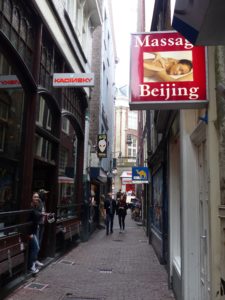
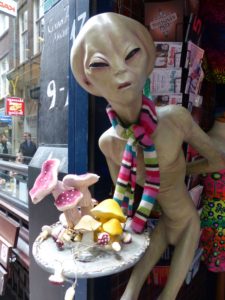
6. The Condomerie
Warmoesstraat 141
Well, here we are at the Condomerie. In 1987, Amsterdam made world headlines when the World’s first Condom Specialty Shop opened its doors. The treasure trove of latex artistry was founded to break the taboo surrounding condoms. The owners present an awesome collection of fun condoms in all sizes and shapes, sell allergy-free condoms and educate in the usage of female condoms. But what’s new in liberal Amsterdam? Already in the 18th century, there was a condom shop in town. Recently, a 200-year-old condom, about 19 centimeters long, sold at auction for 600 euros. Not bad for an ancient condom made of sheep gut. The world’s most expensive condom will be on display in Amsterdam soon.
Opposite the Condomerie, walk into Papenbrugsteeg and cross the Damrak. Turn a little to the left and take a direct right into Zoutsteeg.
You will have already noticed that the Dutch have a tolerant approach to soft drugs. And in this alley you see another smartshop and a coffeeshop. Today, there are about 200 coffee shops in Amsterdam, where you can buy cannabis. The Netherlands is home to the smartest shops in Europe, selling psychedelic drugs, smart drugs and related literature. Don’t forget to take a selfie with the alien in front of the Alien Visitors Smartshop at No. 13.
Let us continue our tour and walk on to the Gravenstraat, heading towards the tasting room called ‘De Drie Fleschjes’, meaning the three little bottles. This bar was founded in 1650. It has modelled for the KLM collection and is miniature No. 80.
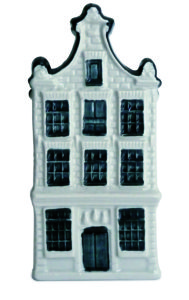
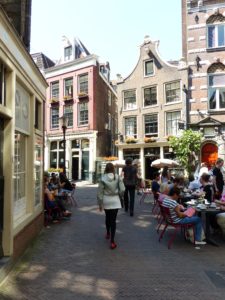
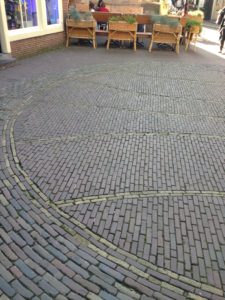
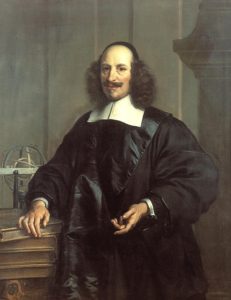
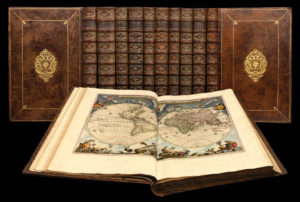
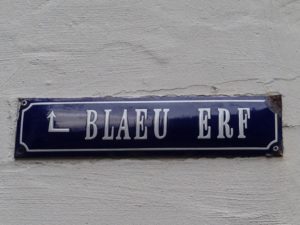
7. Cafe De Drie Fleschjes (KLM-house No. 80)
Gravenstraat 18
At the right hand corner is our next stop. It is café ‘De Drie Fleschjes’. Look down at the pavement in front of the bar. Do you see that pattern of yellow bricks in the shape of a globe? It refers to the printing house of the publisher and cartographer Joan Blaeu, which used to be located behind the café.
In the 17th century, Amsterdam was home to more than a thousand printers and booksellers. For foreign dissident writers it was relatively easy to publish their work in Holland. Although Joan Blaeu entertained Remonstrant sympathies, he printed books for Catholics, Jews and various Protestant groups. A lot of free thinkers flocked to Amsterdam to visit his printing house, next to the café De Drie Fleschjes.
Joan Blaeu’s publishing house was called The Nine Muses, after the nine printing presses that produced books and world atlases around the clock. However, during a cold winter night in 1672, a fire broke out. But it was so cold, that the fire hoses froze and only the café in front of the large building could be saved. All nine printing presses were lost, and the expensive copper plates that had printed the famous Atlas Maior melted. This atlas, containing six hundred maps of territories all over the world, was regarded as the most expensive book of the Dutch Golden Age, and cost an amazing 6,000 euros. By comparison, in the 17th century, an unskilled laborer would have had to work for five years to buy himself a copy of the Atlas Maior.
The fire was a nightmare for the Blaeu, as his life’s work had literally gone up in smoke. He lapsed into depression and died a year later. The globe made of yellow bricks in front of ‘De Drie Fleschjes’ is a lasting memorial to a great cartographer and a supporter of the freedom of the press.
Turn left into Eggerstraat.
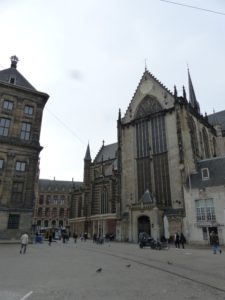
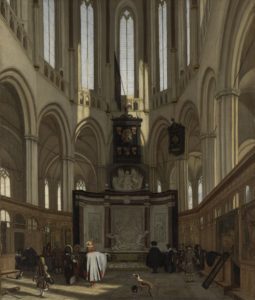
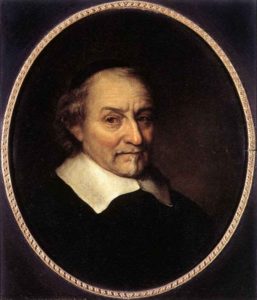
8. Nieuwe Kerk (1408)
Dam
The church opposite café De Drie Fleschjes is called the Nieuwe Kerk, The New Church. But don’t be fooled by its name because ‘new’ only means that it was built after the Old Church, where we started our tour. This new church was built around 1400, because Amsterdam had a shortage of churches. Almost two hundred years later, when Catholicism was forbidden, the statues and altarpieces were removed or destroyed and the walls were painted white.
Today, the 600-year-old Nieuwe Kerk is the most visited and most important Protestant church in The Netherlands. Since 1814, the Dutch monarchs have been inaugurated here and it was also used for royal weddings. Inside you can see the graves of many famous Dutchmen, such as the poet Joost van den Vondel. Despite the fact that he converted to Catholicism in 1641, he was buried in this Protestant Church.
Continue your tour towards Dam Square.
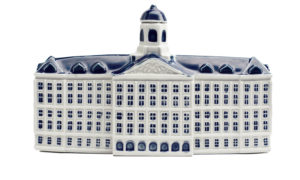
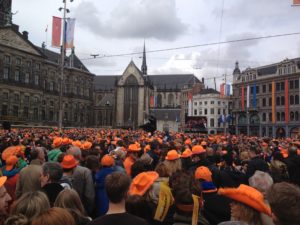

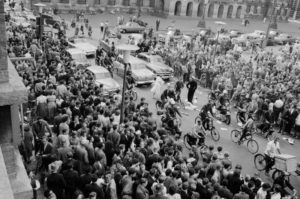
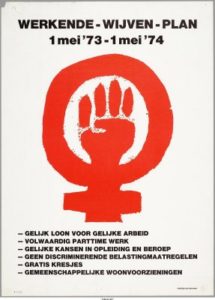
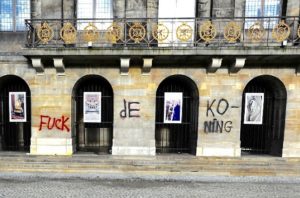
9. Royal Palace Amsterdam (KLM-collector’s item)
Dam Square
Right in front of you is the Dam Square with the Royal Palace. This square is the nation’s most important square, and has been the site of support and protest for centuries. Whether you are a supporter of something or against a cause, you get a platform in front of the Royal Palace as long as you stick to the rules. Dam square has staged many protests, happenings and sit-ins. Some were peaceful; others culminated in violent clashes with the riot police.
In the 1960s, the anti-establishment movement Provo, which derived its name from the word ‘provoke’, held its demonstrations here. In 1966, the anarchists gained world attention by rioting on the wedding day of Crown Princess Beatrix. To disturb the festivities, the Provo’s spread false rumors such as feeding sugar cubes containing LSD to police horses. A smoke grenade was thrown at the royal carriage when the newly-weds arrived in Dam Square. In 1970, the Provo’s joined forces with the squatters’ movement and declared the Free State Orange on Dam Square. During the city council elections of 1970, the anti-establishment party won five seats.
That same year, the radical feminist group ‘Dolle Mina’ was founded to discuss women’s inequality in Dutch society. The female activists protested in front of the Royal Palace against the male dominated power and authority, they burned their bras and promoted their right to abortion. The feminists gained momentum after a small group of women and loyal men were enraged by that fact that the women were fined less money than men for participating in a sit-in protest.
Pass in front of the Royal Palace and turn left into Paleisstraat. Cross Nieuwezijds Voorburgwal and continue walking. Turn left into Spuistraat.
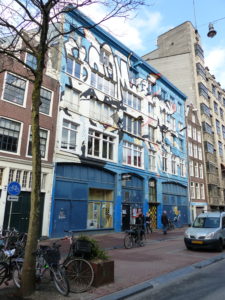
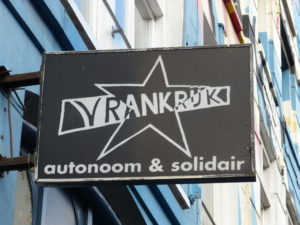
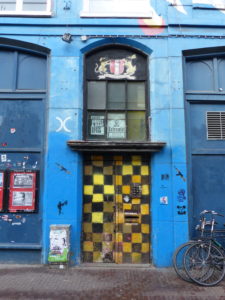

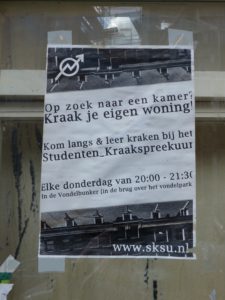
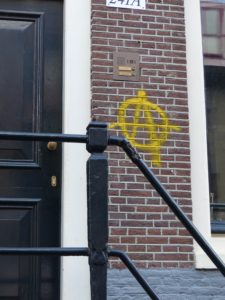
10. Vrankrijk, HQ Squatter’s Movement
Spuistraat 216
One of the most scenic buildings on Spuistraat is ‘Vrankrijk’, the historical center of the squatter’s movement. Especially during the 1970s and 1980s, squatting was almost a necessity among young people in Amsterdam, due to the lack of affordable housing. Squatting was considered legal and as soon as a building was empty for over a year, you could basically move in. Although the facade of this anarchist political and cultural center on Spuistraat is painted in blue and white, it is definitively not an KLM House. And its history is quite turbulent. The building dates back to 1875, and is one of the last squats in Amsterdam.
Vrankrijk is an independent and autonomous squat bar that has existed since the heydays of squatting in the early eighties. It is famous for its debates on politics, globalization, capitalism, animal rights, anarchism and feminism. Bands from the punk, Ska and alternative scene played in the bar downstairs. Since 2010, squatting of a house is considered a criminal offence, and ‘Vrankrijk’ has been threatened periodically with closure. The Amsterdam authorities forced the bar to accept legal permits and licenses, but regular police check and control of the activities was out of the question for the activists. ‘Vrankrijk’ was closed in 2008 for several years, and re-opened in 2010.
According to the squatters’ movement, some 35,000 people in the Netherlands have lived in a squat at some time in their lives. Opposite the ‘Vrankrijk’-building is ‘the Snake House’. Its facade is a gradient from bright orange to sunny yellow, with a colorful snake dropping down from the roof to greet you just above eye level with an open-mouthed grin. It was painted in 1987 as a protector against bad spirits. The residents of the ‘Snake House’ were summoned to leave the building in 2015.
Turn back the way you came and turn left at the corner into Paleisstraat. Turn right and walk into Singel. Turn left and cross the bridge. At the other side of the canal, turn right and keep walking along Singel. Keep walking along Singel.
Of course you know Rembrandt’s famous masterspiece The Night Watch, which is in the Rijksmuseum. Well, a bit further is the house where one of the main characters in the painting lived: captain Frans Banninck Cocq.

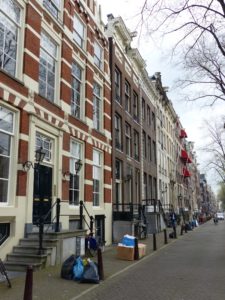
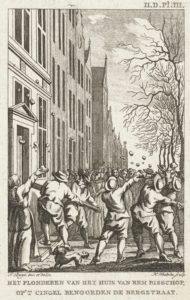
Next to it, is the 17th century house of Rem and Lysbeth Bisschop, the couple connected to the secret annex in which the Jewish girl, Anne Frank, and her family hid during the Second World War.
11. The house of Rem and Lysbeth Bisschop
Singel 138
On Singel 140, lived one of the most famous models in Dutch art history: captain Frans Banning Coq. He is depicted in Rembrandt’s Night Watch, as he is leading his company. The painting, completed in 1642 at the peak of the Dutch Golden Age, is in the Rijksmuseum. and if you go there, you’ll discover that Rembrandt did not make people more beautiful than they were. Besides from being the greatest Dutch master of the Golden Age, Rembrandt was also a free thinker and steered his own course. Throughout his career, he pushed against the boundaries of what was thought acceptable and appropriate in art. He tried to render reality as faithfully as possible, and didn’t beautify the people he portrayed.
Next to this historic building, on number 138, is a special house with a special history. At the beginning of the 17th century, a merchant called Rem Philips and his wife Lysbeth moved into this house. As members of the Remonstrant Church, Rem and Lysbeth were persecuted for their faith. At times, the services in the clandestine church they visited were disrupted by spies who alerted the police. In 1617, Rem was sought for collecting funds and had to go into hiding. In the meantime, his wife was arrested, but she refused to disclose his whereabouts. An angry crowd forced its way into their house and destroyed their furniture. A few months later, the couple moved to Keizersgracht 186. Behind their next house, two warehouses were built to store soap. Ultimately, these buildings became the secret annex where Anne Frank and her family hid during the Second World War. Before we visit that location, let us first walk to Singel 87, and hear another story about freedom of speech and tolerance.
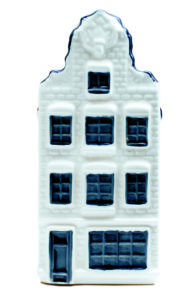

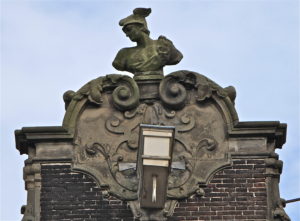
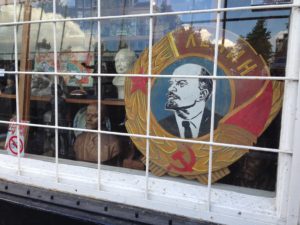
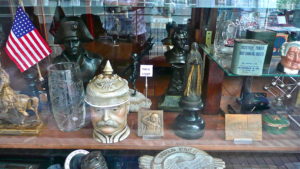
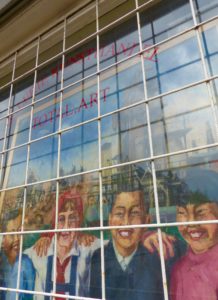
12. Totalitarian Art Gallery
Singel 87
You see that little shop at the other side of the canal on the corner on number 87? That used to be the Totalitarian Art Gallery (and KLM house number 72). Around 1730, a merchant called Jan de Nijs had a warehouse built there, with six floors and an attic. The tall neck gable with a hoist beam was decorated with sculpted wings and vases. The bust atop the house represented an image of the Greek God Hermes, the protector and patron of invention, travelers and trade.
In 2007, an art trader entered the niche market of controversial political art and curiosities of a non-democratic nature. In the former warehouse, he established his Totalitarian Art Gallery. Attracting travelers from all over the world, the owner exhibited and sold work from the former Soviet Union, North Korea and the Third Reich. The window showcased striking historical objects like a bust of Stalin, an Olympian athlete giving the Nazi salute and other reliquaries from a distant past.
In 2013, a signed copy of Adolf Hitler’s forbidden book ‘Mein Kampf’ sparked a row. Three years later, the appeal court ruled that sentencing the owner of the gallery would contravene the right to free speech. In addition, the book has played a prominent role in history and is freely available on the internet. The art trader not only sold Hitler’s memoir as an historical artifact, but also the Diary of Anne Frank. The gallery was closed in the spring of 2016.
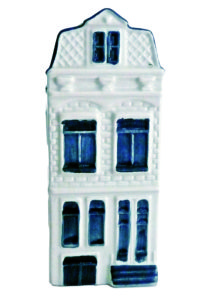
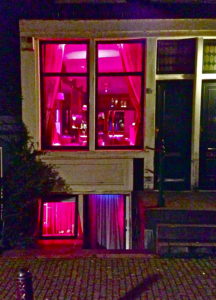
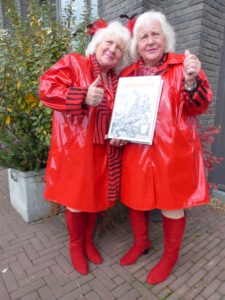
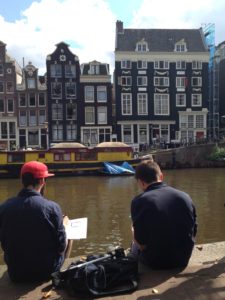
13. Small Red Light District (KLM-house No. 71)
Further down the canal is Singel No. 81. You can see it from here. This house, built in the 1890s, was made into another KLM replica, it’s miniature No. 71. In the 1970s, the first floor and the basement were converted into a venue for window prostitution. Since the start of the 20th century, window prostitution has officially been tolerated in this area, although it is practiced on a much smaller scale than in the Red Light District. About 30% of the prostitutes work behind red-lit windows, and most rooms are rented out twice a day to different women.
During the week, the basement and ground floor of Singel 81 are the domain of prostitutes from Costa Rica and the Dominican Republic. Two Thai women, a pair of twins, work shifts at the weekends. In the early 1970s, a now famous set of Jewish twins worked here too. Martine and Louise Fokkens, now in their seventies, have been in the business for over 50 years and they are local celebrities. The business taught them to get along with all sorts of men; from priests to imams and rabbis and everything in between. Since their retirement, the twins have published several books and worked on a documentary. Today, the only roles they play is that of being loving grandmothers, spoiling their grandchildren.
Turn left into Blauwburgwal, cross the bridge and turn left into Keizersgracht.
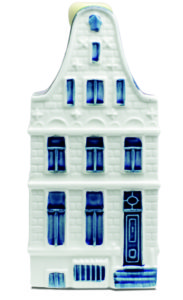
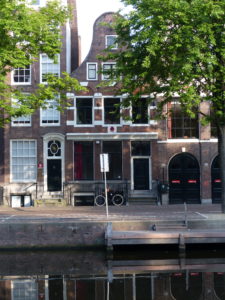
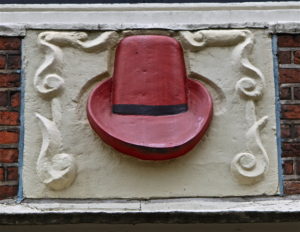
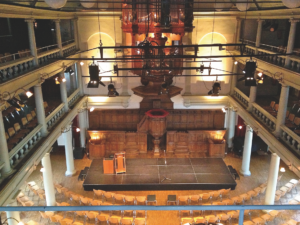

14. Clandestine church ‘The Red Hat’ (KLM-house No. 40)
Keizersgracht 104
We are approaching our first clandistine church on this tour. It is on your right, at number 104. In the late 16th-century, Prince William of Orange led the revolt to gain independence from the Spanish king, Philip II. It was the time of the Spanish Inquisition, known for its bloody religious violence, with trials and torture. They persecuted anyone who was not Catholic.
The independent Republic’s religious freedom contributed to a stable society of optimism and innovation, but, despite popular belief, religious freedom was in reality less free. Officially, churches and religions other than the Reformed Calvinist Church were forced to go underground. Religious communities had to buy a ‘shelter church license’ to escape persecution. The license cost as much as 10,000 euros a year. But this was no guarantee of uninterrupted services.
In 1629, the forbidden Remonstrant community was looking for a suitable location for their shelter church. They purchased Keizersgracht 104 and turned it into a place of worship. A hatter ran his business next door, making customized capotains; broad-brimmed hats of woolen felt, beaver hair, silk or velvet. In the 1630s, the hat-making business was sold to Claes Harmensz Roothoet. His last name literally means ‘red hat’, so the image on the gable stone on the façade was painted in red.
In 1642, the house came into the possession of the Remonstrant church too, and was connected to the shelter church at number 102. It became the largest clandestine church in the Netherlands. Thanks to the freedom of religion laws laid down in 1848, the Remonstrant parish could now show itself publicly. In 1876, the church underwent renovation work and was given a new, typical 19th-century facade. After a period of disuse, the church is now an independent cultural debate center focused on religion, philosophy, music and poetry.
The Red Hat was not the only clandestine church along the Keizersgracht. In fact, a second one is located nearby, at number 140.
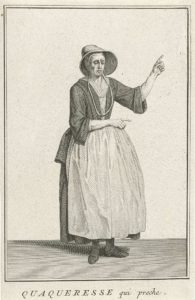
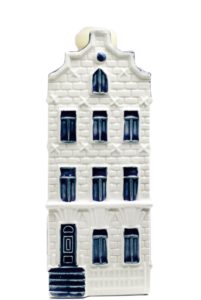
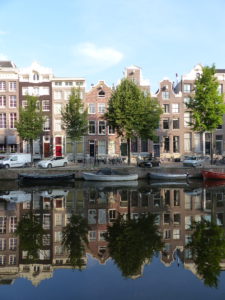
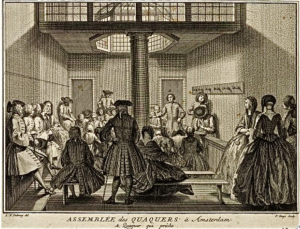
15. Clandestine Quakers church (KLM-house No. 45)
Keizersgracht 140
In 1675, a mysterious widow purchased this house on number 140, backed by a secretive group of investors. A forbidden religious society settled into its new premises. This Quaker Community rejected sacraments, rituals and formal ministry, and held meetings at which any member could speak. In the 18th century, the Quakers played a key role in the abolition of slavery. In 1896, fire broke out on the top floor. The fire brigade managed to save the building, but the grand, old stepped gable in the style of the great architect Hendrick de Keyser was burned beyond repair. It was removed and replaced with a simple, brickwork top. The house has been a private residence ever since.
Continue along Keizersgracht, cross the bridge and turn right onto Leliegracht. Turn left into Prinsengracht.
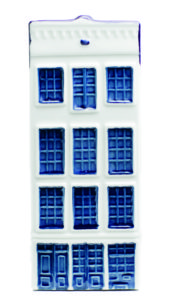
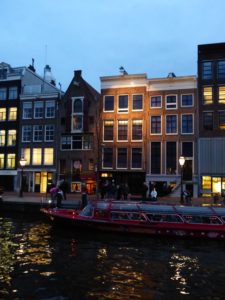

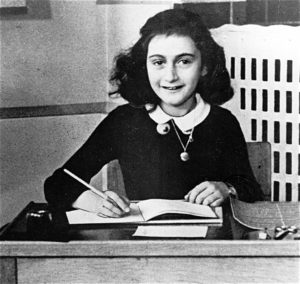
16. Anne Frank House (KLM-house No. 47)
Prinsengracht 263
Anne Frank’s House is probably the world’s most famous Dutch house. In 1635, the first houses along this part of the Prinsengracht were constructed. At the rear of number 263, two warehouses were built for Rem and Lysbeth Bisschop. You remember them. I talked about them earlier. In the 1930s, Jews in Germany were made into second rate citizens by the Nazis. At that time, the Frank family lived in Frankfurt. Anne’s father, Otto, heard disturbing rumors about concentration camps and he and his wife Edith decided to flee to Amsterdam, with their daughters, Margot and Anne.
On July 5, 1942, Margot was summoned to report for labor camp. The next day, the Frank family went into hiding. Before that, Otto Frank had been carefully preparing the empty annex of his office for just such an eventuality. His business partner, his wife and their son hid there, too.
About two years later, on Friday, August 4, 1944, the people hiding in the secret annex were betrayed and deported to concentration camps. Two months before the end of the war, Anne Frank and her sister died at Bergen-Belsen.
During the war, Anne wrote a diary. She often mentioned the carillon of the tower in front of you. It kept the people in hiding awake at night, but she liked it. She wrote: ‘Father, mother and Margot still can’t get used to the chiming of the Westertoren clock, which tells us the time every quarter of an hour. Not me, I liked it from the start; it sounds so reassuring, especially at night’.
When Anne’s diary was published in 1947, it took the world by storm. The story of Anne Frank painted a shocking picture of the life of a teenage Jewish girl forced to go into hiding to flee Nazi persecution. The manuscript was translated into 55 languages and has sold over 27 million copies to date. The house where she hid is now a museum.
Turn left into Westermarkt.
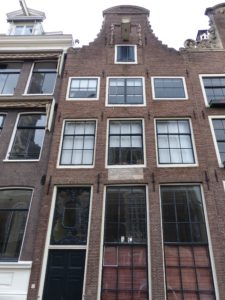
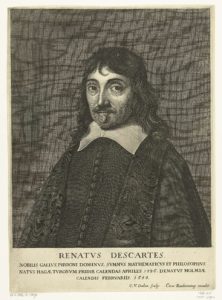
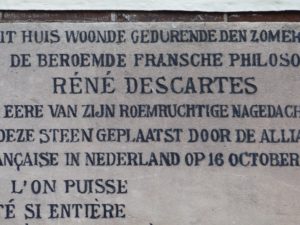
17. René Descartes
Westermarkt 6
You see the commemorative plaque on the façade of the house at Westermarkt 6? In the summer of 1634, the highly influential French philosopher, scientist and writer, René Descartes, lodged here. Before that, he had been forced to flee France to avoid prosecution. His beliefs about truth and the ways to acquire real knowledge by using one’s mind became controversial and he faced direct opposition from the Pope. René Descartes felt at home in Holland, and spent about twenty years of his life in the Dutch Republic. ‘In what other country could I find such complete freedom’, he wrote in 1631 in a letter to his friend Balzac. Descartes was intrigued by the concept of freedom, and developed theories about the freedom of choice and freedom of will. In Amsterdam, Descartes wrote his final published work, a ‘Treaty on the passions of the soul’, allegedly inspired by his affair with a maid called Helena, with whom he had a daughter.
Walk towards the canal, Keizersgracht, and turn right.
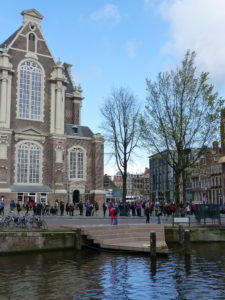
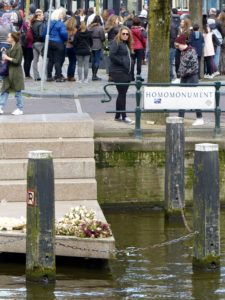

18. Homomonument
Westermarkt
You see the three triangles of pink marble next to the canal? This monument was designed to ‘inspire and support lesbians and gays in their struggle against denial, oppression and discrimination’. The idea of a memorial to gay and lesbian victims of persecution dated from 1970, when gay activists placed a wreath at the National War Memorial in Dam Square to commemorate gays and lesbians murdered by the Nazis. The wreath was removed by police and denounced as a disgrace. The alignments of the three points of the larger triangle are symbolic. One points towards the National War Memorial in Dam Square. One points towards the Anne Frank House and the third points towards the headquarters of COC Nederland, the oldest gay and lesbian organization in the world.
You see that bridge, right in front of you? That is the Niek Engelschmanbrug. He was a Dutch actor, gay rights activist and member of the resistance group against the Nazi’s during the Second World War. You see, a lot of aspects of freedom come together in this part of Amsterdam.
Cross the bridge and walk east into Raadhuisstraat. Turn right here into Herengracht.
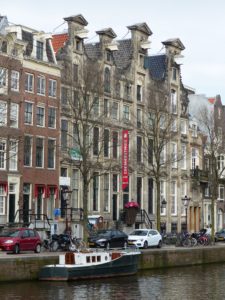
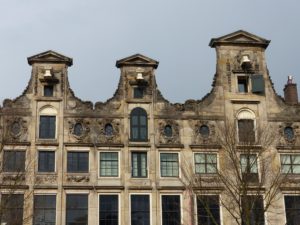
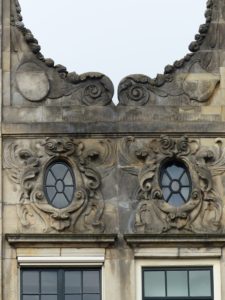
19. Biblical Museum
Herengracht 366
To the religious, the Netherlands have always been a tolerant, safe place of refuge, but the situation was completely different in the 16th century, when the country was part of the authoritarian Spanish king, Philip II’s empire. The fanatical catholic king made Catholicism into state religion. Those who refused to become Catholic were punished by death. The Dutch fought with all their might to secure religious freedom. The struggle was not in vain and eventually led to the founding of the Dutch Republic in 1588. For eighty years, various Spanish kings tried to regain control over our country, but in spite of its small size, it surpassed Spain in terms of power and prestige. In 1648, Philip IV gave up and signed the Peace treaty of Münster. It was one of the key events in Dutch history. The treaty also reaffirmed the principle that the one ‘who rules the territory, determines religion’.
Further down Herengracht, at number 366, you’ll pass the Amsterdam’s Biblical Museum. It tells the fascinating story of how the Bible came into existence, and the influence that the book has had on Dutch society throughout the ages. Today, some 8.5 million Christians live in the Netherlands. 11% of them are members of the Roman Catholic church. There are about one million Muslims, 30,000 Jews and 180,000 followers of other faiths. Seven million Dutch people are non-religious.
Continue along Herengracht.
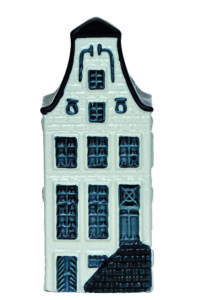
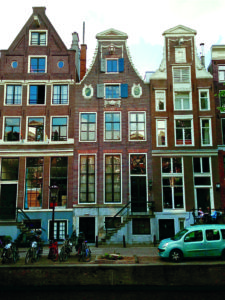
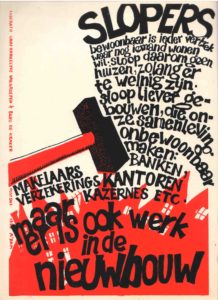
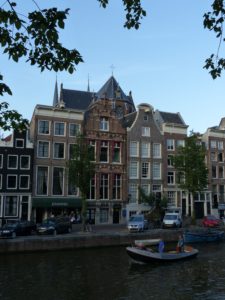
20. Squatting in the Netherlands
Leidsegracht 10 (KLM-house No. 9)
Let’s have a look in the first street on your right. It is the Leidsegracht. And if you walk towards number 10, you’ll see a beautiful monument, built in 1665. This is also a KLM house (number 9). We’ve talked before about squatting in the Netherlands, when we passed the building ‘Vrankrijk’ on Spuistraat. On November 23, 1997, squatters forced the door of this house on Leidsegracht in broad daylight and took possession of the building. Of course it was a clandestine occupation of a building and it had to be resolved in court. In October 2010, a new law banned squatting and the maximum penalty was set at one year in prison. The squatters were forced to leave the building.
Walk back to the canal and turn right across the bridge.

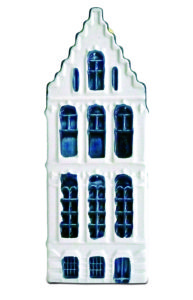
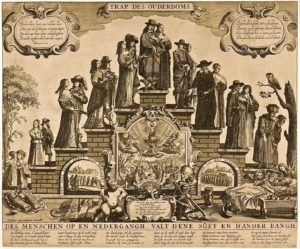
21. The Boekman Foundation (KLM-house No. 52)
Herengracht 415
On this walk through history, we come across many different gables, from 16th- century stepped gables to neck gables, bell gables and other shapes. Approximately one hundred stepped gable houses can be found in Amsterdam today. An example of this feature of Renaissance architecture can be seen opposite the canal. Just look at the magnificent house opposite the canal at number 415. In 1891, this house underwent a complete facelift. The original façade was replaced by a traditional stepped-gable to give the house a historic look. The architect was inspired by the symbolism of the ‘life stairs’, a notion that had been very popular in the Netherlands since the 16th century. The steps of the gable symbolized the seven consecutive phases of human life.
In the 19th century, the Industrial Revolution ultimately led to an overall increase in wealth, but personal progress was unsteady. Modernization even caused fear among people, and the more traditional supported a revival of historicist architecture. So it looks really old, but it isn’t. If you think back to the previous house we saw, at the Leidsegracht dating from 1665; that looks even more ‘modern’.
Walk back the way you came. Pass the Biblical Museum and cross the bridge on your right. Continue through Wijde Heisteeg and cross the next bridge.
In the 20th century, one of the characteristic aspects of modern Dutch society began to evolve – people from different religions and class, separated from each other and re-grouped, drawing ideological lines in the sand to define their islands. The tolerance and enlightenment of the 18th century seemed to have faded away. The main three pillars of Dutch society in the 20th century were Protestant, Catholic and Social-Democratic. For decades, these pillars provided a structure and stability, and in general the members shared the same values and morals. In the 1960s, however, Dutch society rapidly changed. Under the influence of a cultural revolution, the country witnessed the rise of youth, student and feminist movements.
Continue along Heisteeg to a small square, het Spui.
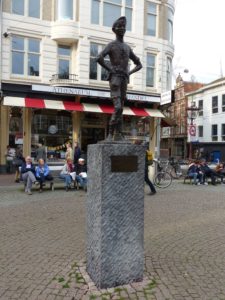
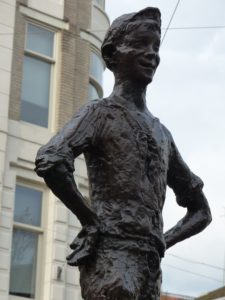
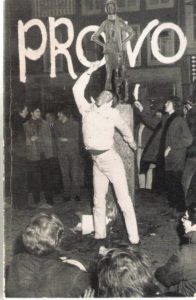

22. Statue Het Lieverdje
Spui Square
This small square surrounded by bookstores and bars is called Het Spui. You see that statue of a young boy in the middle? It represents the youth of Amsterdam. The innocent street boy is called ‘Het Lieverdje’ (Little Darling), who is always playing pranks yet has a heart of gold. In the mid-1960s, he became a symbol for the Provos, a provocative anti-establishment movement. According to the anarchists in the mid-sixties, the new revolutionary class was a non-class. The youth felt that they had no stake in the economy, so cultural sabotage was the only way for them to express their freedom.
Every Saturday, at midnight, the bronze statue was the focal point of scores of singing and chanting long-haired, denim-clad young people. In 1966, the Provos participated in left-wing student protests against the Vietnam War. The gatherings provoked police officers who were puzzled by the performances. Demonstrations were banned, but that resulted in riots and hundreds of arrests. The brutality of the police increased the sympathy for the anti-war demonstrators among the general public. Eventually, the events led to the resignation of the mayor of Amsterdam in 1967. After he had been removed from power, the anarchist decided to end Provo.
Cross the street and turn left on the Nieuwezijds Voorburgwal and walk on.
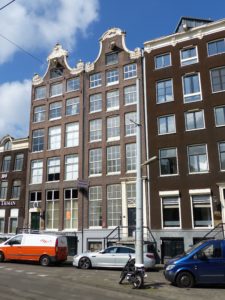
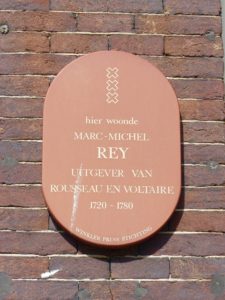
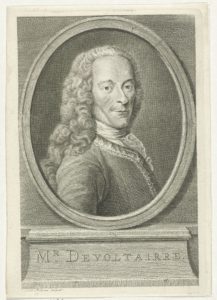
23. Publishing house Marc-Michel Rey
Nieuwezijds Voorburgwal 296
Let’s go back a few centuries again. But we see that every era needs a refreshing breeze to cool off the atmosphere and to secure progress. In the 18th century, it was the movement of the Enlightenment, sparked by free-thinking men such as the French philosopher Voltaire, that promised sweeping changes. Voltaire advocated the separation of church and state, freedom of religion and freedom of speech. During his life, Voltaire wrote about 2,000 books and political pamphlets. A good portion of his work was suppressed, and he lived in almost constant fear of arrest. The French authorities even ordered certain of his books to be burned. To combat his censors, Voltaire had many of his books printed abroad. In Amsterdam, the publisher Marc-Michel Rey accommodated him on Nieuwezijds Voorburgwal 296, which is a bit further. Rey was the most important publisher in the French language in Holland. Freedom of the press was one of the reasons why he himself moved from Geneva to Amsterdam. Marc-Michel Rey published material that was offensive to the church, such as the writings of Voltaire and his attacks on the priestly order. The French philosopher was several times forced into exile, and lived for a number of years in the Netherlands.
Turn right into Sint Luciensteeg to the Amsterdam Museum.

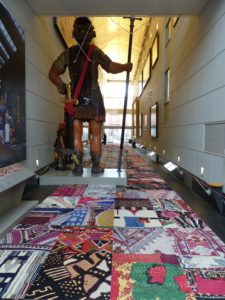
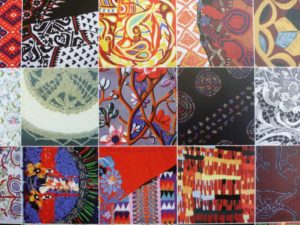
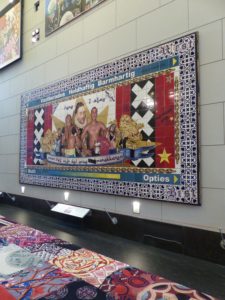

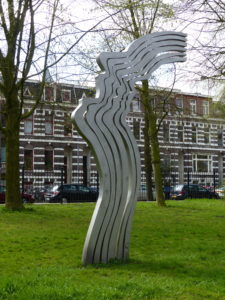
24. Celebration of Diversity
Civic Guards Gallery/Amsterdam Museum
Let us enter the courtyard of the Amsterdam Museum. The city’s historical museum is housed in a 16th century building which was originally the convent St. Lucien and a former orphanage. Via the Civic Guards Gallery, we walk over a majestic 40-meter-long carpet. This piece of art is a celebration of diversity. All 180 nationalities in Amsterdam are represented here. The colours and patterns of all cultures of Amsterdam form a decorative patchwork. Close up, the pieces of the puzzle each tell a story of how many people came here in search of a tolerant climate, just as Voltaire did in the 18th century.
The struggle for tolerance is a constant factor in Dutch society. On November 2, 2004, film director Theo van Gogh was murdered in Amsterdam. The murderer was a Muslim fundamentalist who saw Van Gogh, a descendant of the famous Vincent van Gogh, as an enemy of Islam; others saw him as a hero who stood for freedom of speech. In this portrait, a graffiti artist commemorates the murdered film director. If you want to visit his memorial, it is in Oosterpark, near the place where he died.
When you leave the gallery, continue to the Begijnhof.
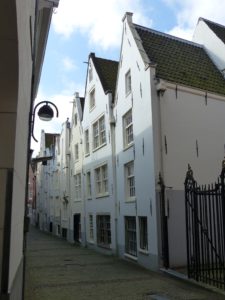
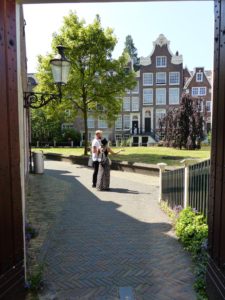
In 1737, Voltaire, the French philosopher had nothing but praise for the Dutch. ‘I would have liked never to leave Amsterdam. Its liberty, its scholarliness! This society has completely enchanted me’, he wrote. But was he also excited about the women here? After all, opposite the printing house of his publisher on Nieuwezijds Voorburgwal was a community of single women living together. Voltaire, a bachelor throughout his life, had many mistresses and lovers.
The women of the Begijnhof-community are nowadays considered to be the first feminists of Amsterdam. Since the 14th century, they took care of the sick and poor, and formed their own religious community without the dogmas of other convents or churches. ‘Beguines’ were not nuns, nor were they bound to remain secluded. They just wanted to make a difference and were free to leave.
Continue along the Gedempte Begijnensloot and turn right into the next alley.
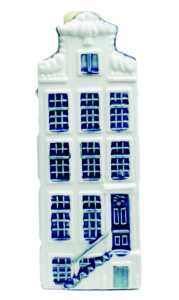
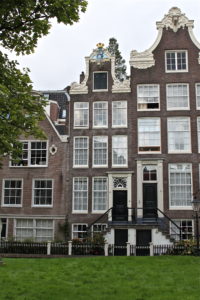
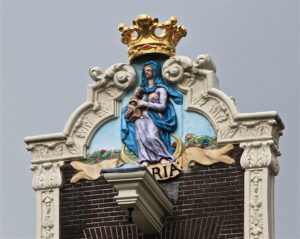

25. The Ivory Tower (KLM-house No. 46)
Begijnhof 27
You’re entering now The Begijnhof. It consists of a number of houses surrounding a small courtyard. Since its foundation, The Begijnhof has been home to hundreds of single women; if they wanted to get married, they had to move out. In the 18th century, new rules were drawn up for the Beguines, to limit any kind of licentious behavior. Some are noteworthy for their peculiar details: ‘In order to prevent disquiet in the courtyard, no cockerels or dogs may be kept. Also, no female friends of the Beguines, nor any others, may stay the night without permission from the mistress; and boys over three years may never stay the night.’
The house at Begijnhof 27 across the lawn was built in around 1740 and is nicknamed ‘The Ivory Tower’. See if you can find it. The Ivory Tower refers to the Biblical Song of Solomon and was used as an epithet for Mary. The image of a tower can be seen above the door. The lavishly decorated, 18th-century clock gable is topped by a baroque capital and a golden crown. The most striking detail is the Madonna figure holding a child. As a symbol of chastity, she stands on a golden, crescent moon. During restoration work in 2009, thick layers of paint were removed from the top. To the surprise of the restorers, it was found that Madonna’s bare breast had been painted over. Her breast is a symbol of her special role as a mediator for humanity. The Madonna was returned to her rightful, but more revealing, state of dress as part of the restoration.
Turn around and walk back the way you came. Cross Gedempte Beijnensloot and continue along Begijnensteeg. Cross the Kalverstraat and continue along Watersteeg. At the end turn right and the take first street on your left, which is called Rokin. Be carefull when crossing this street. Keep walking east into Lange Brugsteeg.
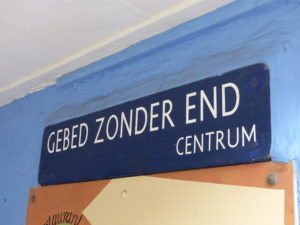
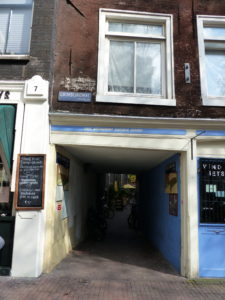

26. Gebed Zonder End
You see this small alley, on your left. Go in there and continue your walk. In the meantime, I will tell you another story.
This alley is called ‘Gebed zonder End’, which means ‘Endless Prayers’. This is the area where, in the Middle Ages, a some of the twenty monasteries in Amsterdam could be found; sixteen were populated by nuns while devoted monks practiced their faith in three priories. In 1410, just down the road from Begijnhof, the recently established Order of St Mary Magdalene moved into the house of the devout William Roelofsz. He welcomed all women who repented their past lives as sinners and chose to become nuns. There appeared to be sinful women aplenty in Amsterdam, for the house was bursting at the seams! Within a couple of years, the improvised cloister was offering shelter to almost a hundred faithful sisters.
At the end of the alley turn right into Kuipersteeg and at the end turn left.
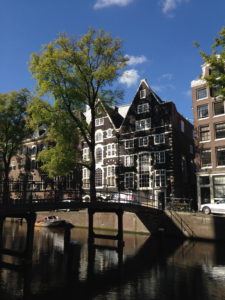
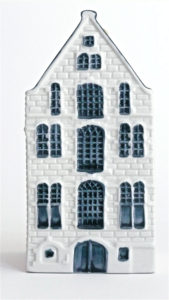
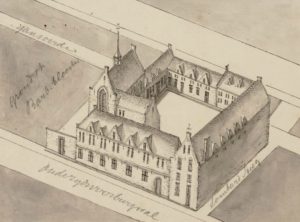
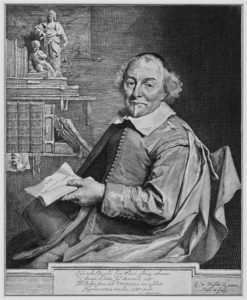
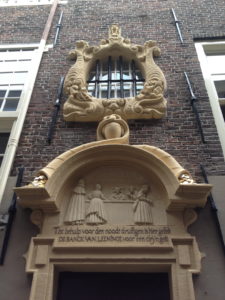
27. The City Bank of Amsterdam (KLM-house No. 37)
Oudezijds Voorburgwal 300
In 1422, the Mother Superior had a proper monastery built at Oudezijds Voorburgwal 300, which we will pass shortly.
But in those times life was not as peaceful as it should have been. The sisters of the Magdalena Convent were regularly at loggerheads with their neighbors; the nuns of the Saint Barbara Convent were territorial and devoted their time to fighting over a small ditch separating the two monasteries. In 1580, following religious civil unrest, the Catholic City Council of Amsterdam was ousted, and the new Protestant rulers closed all of the monasteries and convents. The Magdalena Convent became a house for the poor. The thirteen remaining nuns were tolerated and granted permission to stay there for the rest of their lives.
In 1614, the municipal pawnbroker, Stadsbank van Lening, purchased the former convent. From then on, Amsterdam people with financial problems no longer had to take out loans from private loan sharks. Instead, they got credit at fair rates. In 1616, the well-known architect, Hendrick de Keyser, changed the interior and gave the front and rear facades of the buildings natural stone bands and cross-frame windows.
Just have a close look at the side entrance in the alley. Do you notice the relief over the door depicting three women at a counter pledging their possessions? Further decorations are far from subtle, however, including horns of plenty, an hourglass and a money box. The municipal pawnbroker was originally established in order to provide loans for the “little guy”. But there were plenty of rich people who pawned their possessions in return for hard cash, too. During the Eighty Years’ War, the Dutch uprise against Spanish rule, Prince William of Orange pawned his valuable silver table ware to finance his struggle against Philip II. The English king, Edward III, Anne of Austria and the Queen consort of France were among the royal customers of Amsterdam’s city bank, too.
Continue along this street. We are getting to the end of our tour.

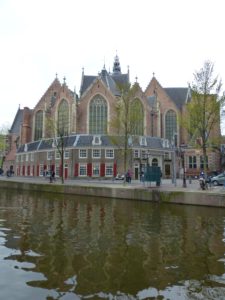
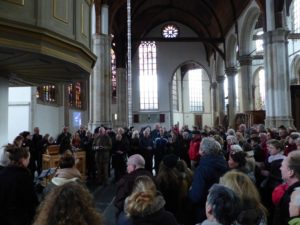
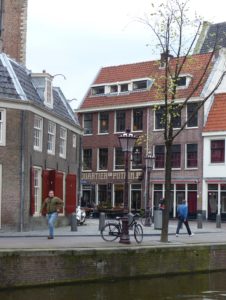
28. The Bulldog or The Old Church
Oudezijds Voorburgwal 90/Oudekerksplein 23
If you take a left into Damstraat, you’ll end at the Dam Square. You can also continue along the canal to the Old Church where we started our tour. Or maybe you want to stop before that, at The Bulldog. They are both great places of reflection and contemplation in their own way. You’ve seen that rich or poor, it really doesn’t matter in Amsterdam. The city is full of contradictions, but we consider every person as equal and they should be treated accordingly. Especially in Amsterdam, people have a reputation for being too direct at times, or one could say rude, but that attitude keeps you connected. We have a great respect for the individual’s freedom to live life as every person chooses.
If you like to read more stories and fascinating legends about Amsterdam, then visit our shop on the website for books like ‘Kingdom by the Sea’. Thank you for being our guest on this tour and see you next time.

Mark Zegeling
Author Kingdom by the Sea,
A celebration of Dutch cultural heritage and architecture
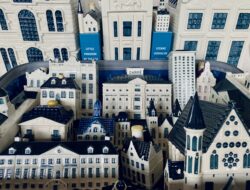



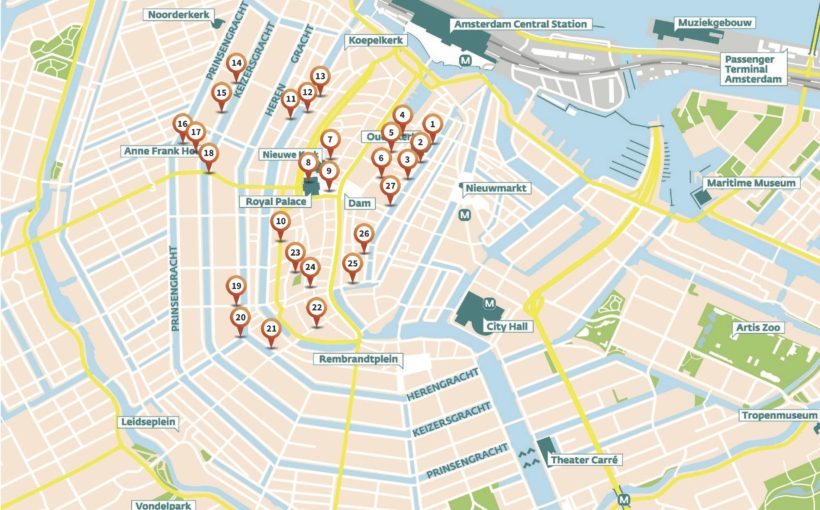
 Frits Bolkenstein
Frits Bolkenstein